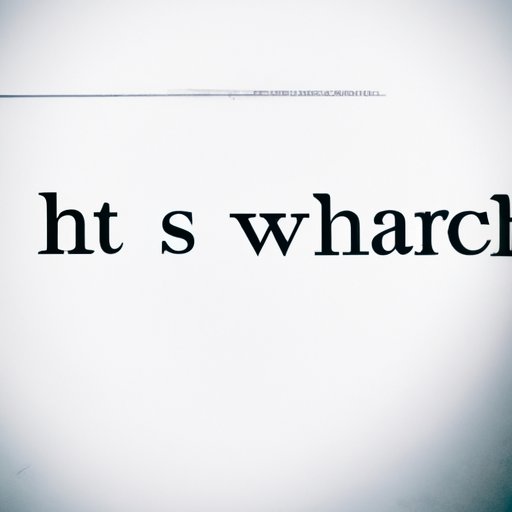Introduction
As a writer, it’s essential to use proper grammar to ensure clear communication and convey meaning effectively. The use of “which” vs “that” is a grammar rule that can often cause confusion, but it doesn’t have to be complicated. In this article, we’ll explore the differences between “which” and “that,” why using them correctly matters, and provide tips and examples to help you avoid common pitfalls in grammar usage.
“Mastering Which vs That: The Ultimate Guide for Clear and Effective Writing”
The first step in using “which” vs “that” correctly is understanding the differences between the two. Simply put, “that” is a restrictive relative pronoun that identifies a specific thing or person, while “which” is a non-restrictive pronoun that adds extra information to the sentence.
Here’s an example: “The book that I read last night was fantastic.” In this sentence, “that” is used because it specifies which book the speaker read.
On the other hand, “I finished reading the book, which took me three days.” In this sentence, “which” adds information about how long it took the reader to finish the book.
Choosing the correct word can be challenging as the two are often used interchangeably, but there are simple rules to follow that can make the process easier.
“A Quick Guide to Choosing Which or That in Your Sentences”
The easiest way to determine which word to use is to identify if the relative clause is essential or non-essential to the sentence’s meaning. If the clause provides necessary information about the subject, then use “that.” On the other hand, if the clause is additional or incidental information, use “which.”
Take this sentence, for example: “I’m looking for the book that my professor recommended.” In this case, “that” is essential because it describes which book the speaker is looking for.
However, consider this sentence: “I’m reading a book about gardening, which I find incredibly relaxing.” In this case, the phrase “which I find incredibly relaxing” is not essential to the sentence’s meaning but adds extra information.
It’s important to note that “which” is always preceded by a comma, while “that” does not require one.
“Why Using Which or That Correctly Matters in Your Writing”
Using “which” vs “that” incorrectly can lead to ambiguity, confusion and alter the meaning of a sentence. For instance, consider the following two sentences:
“The car that I rented was white,” versus “The car, which I rented was white.”
The first sentence implies that the speaker only rented one car, whereas the second sentence suggests that they may have rented more than one car, but the one they had rented was white.
Another example is:
“The movie that I watched last night was terrible,” versus “The movie, which I watched last night, was terrible.”
In the first sentence, the speaker is specifying which movie they watched, implying that they watched multiple movies. The second sentence suggests that the speaker only watched one movie, but it was terrible.
Small differences in wording can have a significant impact on how a reader interprets your writing, making it crucial to use “which” vs “that” correctly.
“Which or That? Tips for Avoiding Common Grammar Mistakes”
Now that you have a solid understanding of the differences between “which” and “that,” it’s time to avoid common grammar mistakes using these words.
Common mistakes include using “which” when “that” is appropriate, using “that” when a pause is necessary, using “which” without a comma and using the wrong punctuation.
To avoid these mistakes, read your sentence out loud, try rephrasing it, and ask someone else to read it for clarity.
“Grammar 101: Understanding the Nuances Between Which and That”
To gain an even deeper understanding of the grammar and syntax behind “which” and “that,” it’s helpful to review how they relate to other parts of speech and sentence structure.
An excellent place to start is understanding that “who” refers to people, while “which” and “that” refer to things and objects.
Also, consider that “which” and “that” can be used in both restrictive and non-restrictive clauses. A restrictive clause provides essential information about the subject, while a non-restrictive clause adds a secondary layer of information to the sentence.
Additionally, notice that when “that” is used, there is no pause or comma between the relative clause and the subject. In contrast, “which” is always preceded by a pause or comma.
“Improving Your Writing Style with Correct Usage of Which and That”
By mastering the use of “which” vs “that,” you can improve your writing style. One of the most significant benefits of correct grammar usage is that it enhances clarity. However, correct usage of the words also gives your sentences a sense of precision and accuracy, making your writing appear polished.
For inspiration on how to use “which” and “that” effectively, study how professional writers use these words in their writing. As you become more confident in your grammar skills, don’t be afraid to experiment with how you incorporate these words into your writing style.
Conclusion
Choosing between “which” and “that” might be tricky, but by understanding the differences, following simple rules, and avoiding common mistakes, you can quickly improve the clarity and impact of your writing. Remember that grammar is essential in conveying meaning effectively, so make it a priority to master the use of “which” vs “that” in your writing.
